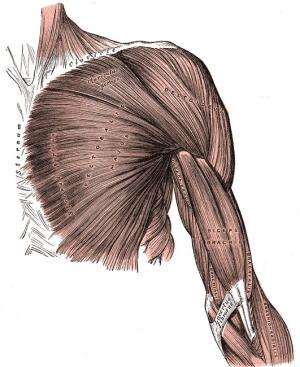June 21, 2013 feature
Muscles act as metamaterials due to collective behavior, physicists show

(Phys.org) —Metamaterials are defined as artificial materials that have been engineered to have unusual properties that are not found in nature. For instance, ordinary materials (say, a rubber band) that are under tension expand in the direction of that tension, while metamaterials may contract, exhibiting "negative stiffness" while still remaining stable. An idea of how this could work in principle was suggested in a 1991 Nature paper by Cohen and Horowitz, and in a 2012 Nature Materials paper by Nicolaou and Motter this idea was implemented to construct an extended material that contracts when tensioned (pulled) or expands when compressed (pushed).
Upon further search for possible mechanisms of negative stiffness, scientists in a new study have found that biological muscles exhibit a mechanical response that also qualifies them as metamaterials: when a tetanized (maximally contracted) muscle is suddenly extended, it comes loose, and if it is suddenly shortened, it tightens up without using any of the metabolic fuel adenosine triphosphate (ATP). The researchers explained that this behavior is due to the folding and unfolding of proteins called myosin cross-bridges that play a crucial role in muscle contraction. Most interestingly, muscles appear to be finely tuned to perform close to a critical point, at which they can exhibit highly synchronized microscale behavior.
The researchers, M. Caruel, J.-M. Allain, and L. Truskinovsky, at CNRS-UMR, Ecole Polytechnique in Palaiseau Cedex, France, have published their paper in a recent issue of Physical Review Letters. Caruel is now at Inria in Palaiseau, France.
As the authors of the new paper explain, skeletal muscles can exhibit two types of behavior: active and passive. Active behavior occurs on time scales of about 30 milliseconds (ms). At shorter time scales, about 1 ms, muscles exhibit passive behavior, including negative stiffness. As the researchers explain, elementary parts of these mechanisms that ensure efficient recovery of forces work as snap-springs, making muscles similar in a sense to shape memory alloys.
A remarkable phenomenon reported by Caruel, et al., is that, in contrast to known smart materials, the micro-mechanisms inside muscles are finely tuned to work in unison, which allows them to perform a highly synchronized stroke. Behind this collective behavior is an internal architecture with domineering long-range interactions, which has been previously overlooked in muscle studies.
Already in 1971, researchers A. F. Huxley and R. M. Simmons at University College London observed the unusual passive mechanical response of tetanized muscles and developed a model of muscle contraction explaining this behavior. This model has since dominated the field, and its impact was based on the impressive scientific reputation of Sir Andrew Huxley, a Nobel Prize-winning biophysicist who served for a long time as President of the Royal Society.
In the paper of Caruel, et al., a seemingly innocent change of the loading conditions in the Huxley-Simmons model has led to the discovery of the collective behavior and criticality, which had been overlooked despite more than 40 years of intense scrutiny of this model in many papers and textbooks.
Quite surprisingly, the cooperation at the nanoscale in muscles was found to be similar to magnetism; moreover, the critical point at which muscles seem finely tuned to perform near is, in this case, a direct analog of the ferromagnetic Curie point. Criticality and the ubiquity of power laws are issues of great significance in contemporary science, giving a framework for understanding the emergence of complexity in a variety of natural systems, from earthquakes to turbulence. Why and how muscle systems are tuned to criticality is an open problem, and the authors argue that it can be the result of either evolutionary or functional self-organization.
Tuning to criticality in muscles has many intriguing parallels in other biological systems. For instance, in a 2011 paper published in Physical Review Letters, Patzelt and Pawelzik showed that when humans perform control tasks like in upright standing or while balancing a stick, their behavior also exhibits power law fluctuations, which suggests a fine-tuning of the underlying mechanical system to a critical point. Similar fluctuations have been also found in the collective behavior of humans; for example, in stock market log-return fluctuations. According to Patzelt and Pawelzik, the criticality emerges when an unstable dynamics as, for instance, in metamaterials with negative stiffness, is stabilized by an adaptive controller that has finite memory.
Overall, the discovery that muscles act as metamaterials due to collective behavior suggests that determining the cause of the critical behavior of muscles may lead to a paradigm change in the biomimetic design of new materials.
More information: M. Caruel, et al. "Muscle as Metamaterial Operating Near a Critical Point." PRL 110, 248103 (2013). DOI: 10.1103/PhysRevLett.110.248103
Z. G. Nicolaou, et al. "Mechanical metamaterials with negative compressibility transitions." Nature Materials, 11, 608 (2012). DOI: 10.1038/nmat3331
Cohen, J.E., Horowitz, P. "Paradoxical behaviour of mechanical and electrical networks." Nature 352, 699 - 701 (1991). DOI:10.1038/352699a0
Patzelt, Felix, and Klaus Pawelzik. "Criticality of adaptive control dynamics." PRL, 107.23 (2011): 238103. DOI: 10.1103/PhysRevLett.107.238103
Huxley, A. F., Simmons, R. M. "Proposed mechanism of force generation in striated muscle." Nature 233, 533-538 (1971). DOI: 10.1038/233533a0
Journal information: Nature , Nature Materials , Physical Review Letters
© 2013 Phys.org. All rights reserved.

















